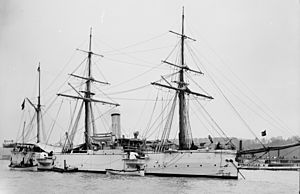Spanish cruiser Isabel II facts for kids
class="infobox " style="float: right; clear: right; width: 315px; border-spacing: 2px; text-align: left; font-size: 90%;"
| colspan="2" style="text-align: center; font-size: 90%; line-height: 1.5em;" | 
|}
The Isabel II was a type of warship called an unprotected cruiser in the Spanish Navy. It was named after Queen Isabella II of Spain. This ship played a part in the Spanish–American War, especially in battles near San Juan, Puerto Rico.
Contents
| History | |
|---|---|
| Name | Isabel II |
| Namesake | Queen Isabella II of Spain. |
| Builder | Ferrol |
| Laid down | 1883 |
| Launched | 19 February 1886 |
| Completed | 1888–89 |
| Fate | Stricken 1907 |
| General characteristics | |
| Class and type | Velasco-class unprotected cruiser |
| Displacement | 1,152 tons |
| Length | 210 ft 0 in (64.01 m) |
| Beam | 32 ft 0 in (9.75 m) |
| Draft | 13 ft 8 in (4.17 m) maximum |
| Installed power | 1,500 ihp (1,100 kW) |
| Propulsion | 1-shaft, horizontal compound, 4-cylinder boilers |
| Sail plan | Barque-rigged |
| Speed | 13 knots (24 km/h; 15 mph) |
| Complement | 173 officers and enlisted |
| Armament |
|
| Notes | 200 to 220 tons of coal (normal) |
Building the Isabel II
The Isabel II was built at the naval shipyard in Ferrol. Its construction began in 1883. The ship was officially launched into the water on February 19, 1886. It was fully completed and ready for service in 1888 or 1889.
This ship had a strong body made of iron. It also had one tall smokestack. The Isabel II was also rigged as a barque, which means it had sails like a sailing ship.
The Isabel II in Action
When the Spanish–American War started in April 1898, the Isabel II was located in San Juan, Puerto Rico. The U.S. Navy began a continuous blockade of San Juan on June 18, 1898. A blockade means they surrounded the port to stop ships from entering or leaving.
First Battle of San Juan
On June 22, 1898, the Isabel II left the port. It was joined by the gunboat General Concha and the destroyer Terror. They wanted to test the American blockade. This led to a fight known as the Second Battle of San Juan.
The American ship USS St. Paul moved in to engage them. A short gun battle happened, but the Spanish ships quickly turned back. The Isabel II and General Concha could only go up to 10 knots (19 km/h; 12 mph) (knots). The Terror tried to launch a torpedo at St. Paul to help the other ships escape. The Terror was badly damaged by gunfire from St. Paul. However, all three Spanish ships managed to get back safely into San Juan port. Only two sailors on the Terror were hurt, and they died. These were the only injuries in the battle.
Second Battle of San Juan
On June 28, 1898, the Isabel II went out again. This time, it was with the General Concha and another gunboat, Ponce de Leon. Their mission was to help a Spanish merchant ship, the Antonio Lopez, get into San Juan harbor. The Antonio Lopez was trying to sneak past the blockade.
The three Spanish warships exchanged long-distance gunfire with the American ships St. Paul, Yosemite, and the cruiser New Orleans. Neither side managed to hit the other. It became clear that the Antonio Lopez could not get past the American ships. So, the Spanish warships returned to port. They stayed in San Juan for the rest of the war. The Antonio Lopez ran aground, but most of its cargo was saved by the Spanish.
End of Service
After the war ended, the Isabel II sailed back to Spain. It was removed from the navy's list of active ships in 1907.
See also
 In Spanish: Isabel II (1889) para niños
In Spanish: Isabel II (1889) para niños

